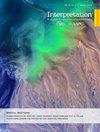利用三维地震反射数据可视化精细的构造和地层特征:以利比亚近海为例
IF 1
4区 地球科学
Q3 GEOCHEMISTRY & GEOPHYSICS
Interpretation-A Journal of Subsurface Characterization
Pub Date : 2023-02-27
DOI:10.1190/int-2022-0056.1
引用次数: 0
摘要
地震反射资料经过处理后含有残余噪声,会造成对噪声敏感地震属性的地质误读。对于详细的地下成像,地震数据调理可以将地下反射特征的可视化提高到地震分辨率的极限。这项对利比亚西部近海Gabes-Tripoli盆地的研究表明,使用标准的工业3d地震数据集对地震数据进行后处理是有潜力的。地震资料显示出明显的反射不连续和构造,解释为褶皱、逆断层和地壳和重力驱动的正断层。其他反射不连续被解释为对埋藏的碳酸盐台地的外部形态和内部结构进行成像。地震反射解释发现,通过过滤对地震数据进行调整,可以有力地支持对不同地下反射特征的三维几何形状、类型和趋势的解释,特别是当它被用作结构属性生成的输入时。后处理地震调节通过结构滤波和边缘保留,初步提高了信噪比。这种过滤器结构的应用强调了支持的细微地质特征,例如,接近地震分辨率极限的断层检测。同时,过滤后的各个地震反射体的横向连续性更高,支持了层位的自动跟踪。与非条件数据生成的结构属性相比,由条件数据生成的结构属性(如方差和曲率)可以成像更多的地下反射细节。提出的基于过滤器的工作流程可应用于大多数地震解释软件包,并建议将其作为有限质量地震反射数据的结构属性计算和结构解释之前的标准程序。本文章由计算机程序翻译,如有差异,请以英文原文为准。
Visualizing subtle structural and stratigraphic features on 3D seismic-reflection data: a case study from offshore Libya
Seismic-reflection data contain residual noise after processing, which can cause geologic misinterpretation of noise-sensitive seismic attributes. For detailed subsurface imaging, seismic data conditioning can enhance the visualization of subsurface reflection features down to the limit of seismic resolution. This study on the Gabes-Tripoli Basin of western offshore Libya demonstrates the potential of postprocessing seismic data conditioning using a standard industry 3D-seismic data set. The seismic data exhibit distinct reflection discontinuities and configurations interpreted as folds, reverse faults, and crustal- and gravity-driven normal faults. Other reflection discontinuities are interpreted as imaging the external form and internal architecture of buried carbonate platforms. The seismic-reflection interpretation finds that seismic data conditioning by filtering strongly supports the interpretation of the 3D geometry, type, and trend of distinct subsurface reflection features, particularly if used as input for a structural-attribute generation. Postprocessing seismic conditioning initially improved the signal-to-noise ratio by structure-oriented filtering with edge preservation. Application of this filter configuration emphasized subtle geologic features supporting, e.g., the detection of faults close to the limit of the seismic resolution. At the same time, the filtering resulted in a higher lateral continuity of the individual seismic reflectors, supporting the autotracking of the horizons. Structural attributes generated from the conditioned data such as the variance and curvature imaged more subsurface reflection detail when compared with the structural attributes generated from nonconditioned data. The filter-based workflow proposed can be applied in most seismic interpretation software packages and is recommended to be used as a standard procedure preceding a structure-attribute calculation and structural interpretation of the seismic-reflection data of limited quality.
求助全文
通过发布文献求助,成功后即可免费获取论文全文。
去求助
来源期刊

Interpretation-A Journal of Subsurface Characterization
GEOCHEMISTRY & GEOPHYSICS-
CiteScore
2.50
自引率
8.30%
发文量
126
期刊介绍:
***Jointly published by the American Association of Petroleum Geologists (AAPG) and the Society of Exploration Geophysicists (SEG)***
Interpretation is a new, peer-reviewed journal for advancing the practice of subsurface interpretation.
 求助内容:
求助内容: 应助结果提醒方式:
应助结果提醒方式:


